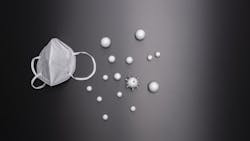Dental aerosols and the pandemic: A necessary wake-up call
Much like blood in the 1980s, with relation to HIV and hepatitis, aerosols took center stage during the COVID-19 pandemic. Most of us didn’t give them a thought previously; then, all of a sudden, aerosols became a dangerous force to be reckoned with. They kept us out of work for weeks, if not months, and many people never returned to the op for fear of the danger they posed.
Of course, aerosols have always been there. There are studies on aerosols and spatter in dentistry going back to the ’60s.1 And in 2004, Harrel and Molinari noted, “There are at least three potential sources of airborne contamination during dental treatment: dental instrumentation, saliva and respiratory sources, and the operative site.”2 It seemed most of that fell on deaf ears, but COVID-19 certainly made us aware of the invisible battle we were facing. While much research has been conducted, more is forthcoming and the recommendations are sure to change with the data. But for now, what do we need to do to stay safe?
Related reading:
Effective aerosol mitigation strategies
A new grad faced with a pandemic
PPE
For a time, I worried we’d be donning spacesuits to see patients safely. Thankfully we haven’t gone that far yet, but it’s essential to wear the proper personal protective equipment (PPE) when treating patients. That includes gowns, eyewear, masks, and gloves at a minimum. Gowns should be changed when soiled and not worn out of the treatment area. Eyewear ideally should have bottom gap protection, per the new American National Standards Institute (ANSI) standards.3 Face shields, with eyewear, can be worn in place of bottom gap protection. We once thought one mask fits all. However, when performing aerosol-generating procedures (AGPs), wearing a level 3, at minimum, or a properly fitted N95 respirator is necessary. Finally, gloves. I mean, we know this one, right? Gloves must be single use with hand hygiene performed before donning and doffing.
Room turnover
Think back to school when we watched the “If Saliva Were Red” video by the Organization for Safety, Asepsis and Prevention (OSAP) (which is releasing a new and updated version in January 2023). Now picture that in aerosol form. We know those aerosols spatter, and droplets end up all over the operatory. Make sure to keep the countertop clutter to a minimum to properly clean and disinfect your clinical contact surfaces. Know the kill time of your surface disinfectant so you’re truly disinfecting your operatory.
Prerinse
While the data is still sketchy, best practices recommend a prerinse before treatment.4 This may decrease the virulence of the aerosols and might lower the bacterial load we introduce into a patient’s bloodstream. It’s fast and easy, so why not try one more thing to reduce aerosols?
Suction
We can no longer rely on dangling a saliva ejector off our patient’s cheek and think we are controlling aerosols. It’s time to incorporate high-volume evacuation (HVE) suction into patient care. When using a proper HVE device with a borehole (i.e., opening) of 8 mm combined with a properly functioning vacuum unit, we can control up to 100% of aerosols. This means two things:
Pick an HVE device that works for you
- Hand-held or hands-free
- Keep ergonomics in mind
Put protocols in place to keep your vacuum working efficiently
- Run your lines at least daily using an atomizer
- Change traps regularly
HVAC
This is the area where I think we will see requirements emerge. There’s lots of talk about regulating the air exchange in our offices. For now, ensure your heating, ventilation, and air conditioning (HVAC) is working properly, and ask your technician if your unit can handle a filter with a 13 or greater MERV (minimum efficiency reporting values) rating to help capture airborne viruses. Consider the use of HEPA (high-efficiency particulate air) filters if your unit is compatible. And if you are replacing your HVAC unit, consult with the American Society of Heating, Refrigerating, and Air-Conditioning Engineers (ASHRAE) on the most current recommendations for dental offices.
Dental unit waterlines
Dental unit waterlines (DUWL) are a significant source of aerosols in dental operatories. In a 2021 study looking at the composition of aerosols created during AGPs, Meethil et al. discovered that 78% of the aerosols were from DUWLs, and 0% came from aerosolized saliva.5 That means that much of what we are breathing is from our DUWLs. It’s key to ensure each office has an established waterline protocol that involves maintenance and quarterly testing.
Regarding aerosol control, most recommendations were in place before COVID-19, but we had a wake-up call to get on board if we weren’t already. I’m grateful that dentistry didn’t turn into a super-spreader, as many feared. We must stay current with best practices and modify them as new recommendations are presented. As health-care professionals, we must keep our team and patients safe, and it’s our goal for each patient to leave healthier than when they came in.
Editor's note: This article appeared in the January/February 2023 print edition of RDH magazine. Dental hygienists in North America are eligible for a complimentary print subscription. Sign up here.
References
- Micik RE, Miller RL, Mazzarella MA, Ryge G. Studies on dental aerobiology. I: bacterial aerosols generated during dental procedures. J Dent Res. 1969;48(1):49–56.
- Harrel SK, Molinari J. Aerosols and splatter in dentistry: a brief review of the literature and infection control implications. J Am Dent Assoc. 2004;135(4):429–437. doi:10.14219/jada.archive.2004.0207
- Svahn C. Dental school research influences new PPE standard. The Tufts Daily. October 30, 2021. Accessed November 8, 2022. https://tuftsdaily.com/news/2021/10/28/ dental-school-research-influences-new-ppe-standard/
- Mohd-Said S, Mohd-Dahm TN, Suhaimi N, Rani H, McGrath C. Effectiveness of pre-procedural mouth rinses in reducing aerosol contamination during periodontal prophylaxis: a systematic review. Front Med. 2021;8:600769. doi:10.3389/ fmed.2021.600769
- Meethil AP, Saraswat S, Chaudhary PP, Dabdoub SM, Kumar PS. Sources of SARS-CoV-2 and other microorganisms in dental aerosols. J Dent Res. 2021;100(8):817–823. doi:10.1177/00220345211015948
About the Author

Amanda Hill, BSDH, RDH, CDIPC
Amanda Hill, BSDH, RDH, CDIPC, is an enthusiastic speaker, innovative consultant, and award-winning author who brings more than 25 years of clinical dental hygiene and education to dentistry. Recipient of ADS’s Emerging Infection Control Leader award and an active participant with the advisory board for RDH magazine, DentistryIQ, and ADS’s Infection Control in Practice Editorial Review Board and membership committee, Amanda (also known as the Waterline Warrior) strives to make topics in dentistry accurate, accessible, and fun. She can be reached at [email protected].
